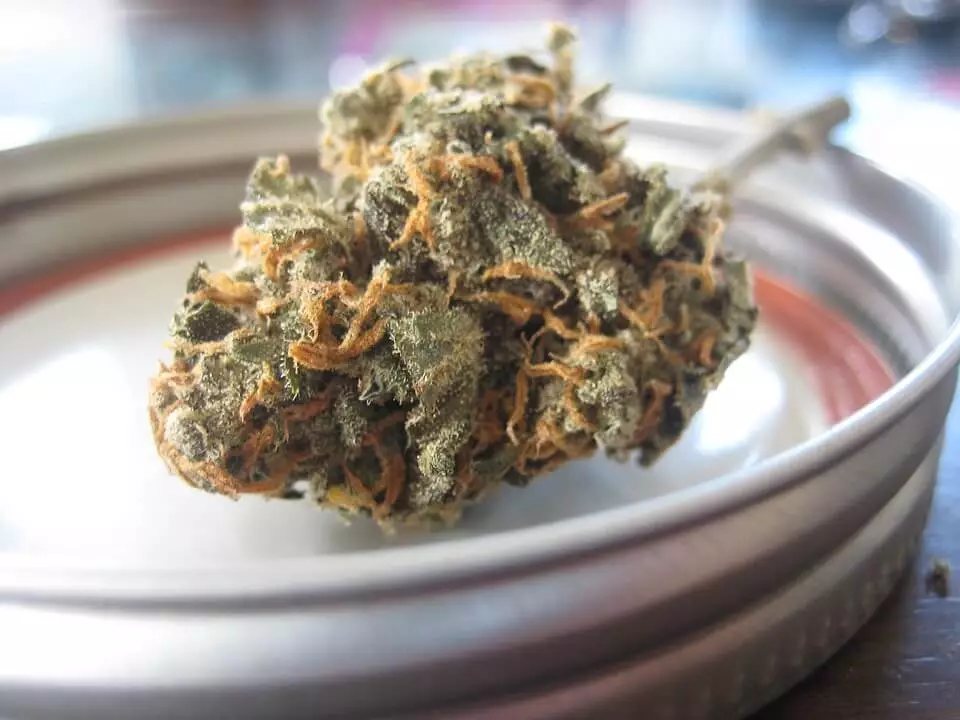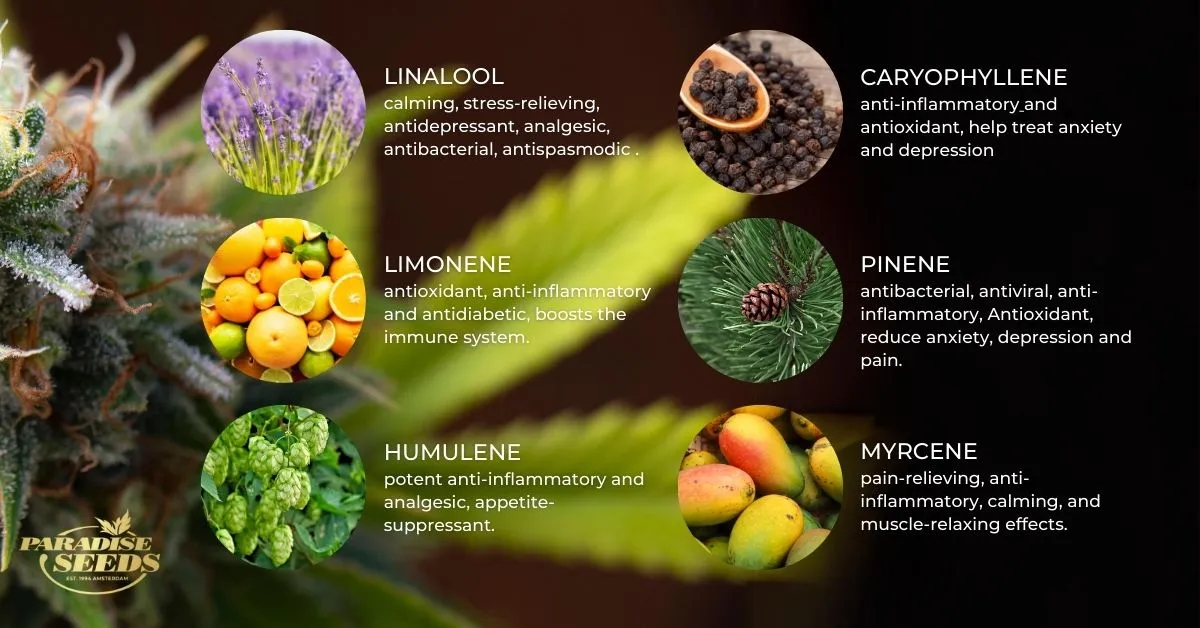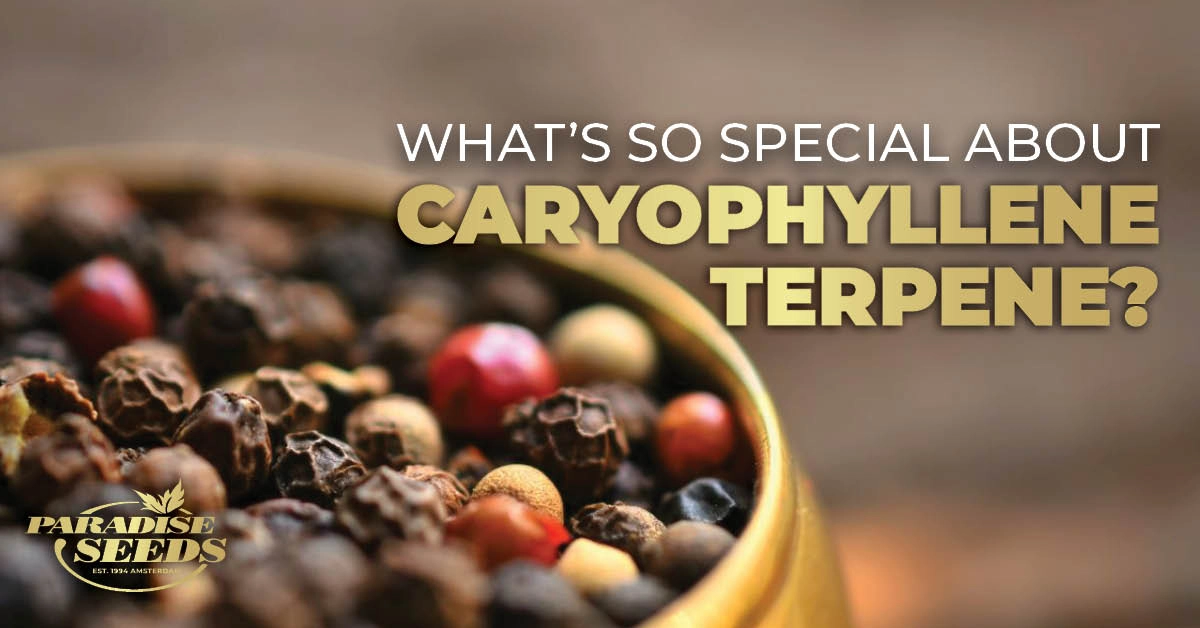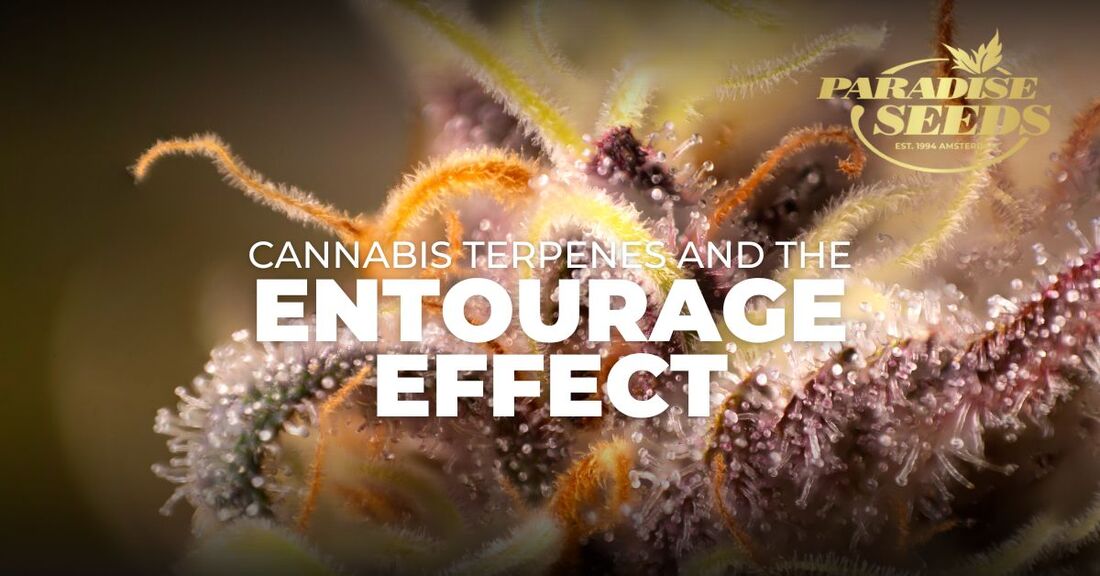In the world of cannabis, the THC to CBD ratio has long been in the spotlight, but in recent years, a paradigm shift has taken place. Attention has begun to focus on terpenes and other cannabinoids, such as CBG and CBN, revealing a complex world of compounds that offer much more than intoxicating and relaxing effects.
Recent studies suggest that terpenes may play a more significant role in both medicinal and recreational effects than previously believed. Dutch seed banks and breeders are now placing a strong emphasis on understanding the terpene profiles of their strains, paving the way for informed choices in cannabis consumption.
Contents
Cannabis terpenes entourage effect therapeutic value
Studies have recently confirmed the synergistic relationship between cannabinoids and the cannabis terpenes entourage effect which have been suspected for decades.
According to a study published in 2021, certain terpenes, such as α-humulene, geraniol, linalool, and β-pinene, can enhance the effects of cannabinoids and potentially increase their therapeutic properties.1
Furthermore, combining cannabinoids and terpenes has shown promise in the treatment of mood and anxiety disorders.2
Dr. Bonni Goldstein, a renowned physician and medical director at Canna-Centers, recommends tailored cannabis combinations for various symptoms3, further emphasizing the importance of understanding the synergistic effect between terpenes and cannabinoids:
- Pain relief: THC + CBD + β-myrcene + β-caryophyllene
- ADD/ADHD: THC + β-myrcene + β-caryophyllene + pinene
- Anxiety: CBD + limonene + linalool
- Depression: THC + CBD + CBG + limonene
- Insomnia: THC + linalool + myrcene
- Inflammation: CBD + CBG + β-caryophyllene
Unlocking the potential of terpenes
Terpenes are the main bioactive compounds of essential oils. These volatile compounds have recently captured the imagination of the cannabis community. Not only are they responsible for the delightful scents and flavors of cannabis strains, but they also possess a myriad of potential medicinal benefits.
With over 30,000 types of terpenes in existence, cannabis alone boasts more than 150 of them4. This gives some idication of the impact of the cannabis terpenes entourage effect.
Terpenoids, on the other hand, are derived from terpenes through oxygenation, and they are still underexplored in scientific research due to their differences in chemical structure. For this article, we’ll focus on terpenes and explore their interactions with cannabinoids.

Beyond scents and aromas
Today, it’s not just Dutch seed banks and American breeders who have realized the therapeutic properties of these compounds, beyond their scent and taste. Recent research has unveiled their potential to boost immune function and alleviate stress, pain, insomnia, and inflammation. Some terpenes can even influence how cannabinoids are absorbed and modify their effects.
Below, we delve into the characteristics of some common terpenes found in cannabis, which conbtribute to the cannabis terpenes entourage effect.
Myrcene (β-myrcene)
The most abundant terpene in cannabis is myrcene, which can account for up to 50% of the total terpene content.5 Myrcene is found in thyme, lemongrass, eucalyptus, hops and mango. The primary characteristics of it are the pain-relieving, anti-inflammatory, calming, and muscle-relaxing effects.6
It also acts as a regulator to enhance or reduce the effects of other terpenes and cannabinoids. One practice noted is how some smokers like to eat a mango 30 minutes before consuming cannabis, as it is said to enhance the psychoactive effects.
Myrcene dominant strains include: El Dorado OG and CBDream.
Linalool
The terpene called linalool is best known as the fragrance of lavender and is well-placed to be associated with the calming, stress-relieving effects of its essential oil. A rat study confirms [4] that inhaling linalool reduces stress levels. Additionally, it has been found to possess antidepressant, analgesic, antibacterial, antispasmodic, and antitumor properties7
Linalool dominant strains include La Bomba.
Pinene
Pinene is the most abundant terpene in nature, especially in pine trees. Its pleasant pine-like scent is also characteristic of various cannabis varieties. Apart from its aroma, pinene is also recognized for numerous health benefits, such as having antibacterial and antiviral properties and enhancing cognitive function.
Pinene is also known for its anti-inflammatory and antioxidant properties, as well as its ability to reduce anxiety, depression and pain caused by migraines and neuropathic pain8. In nature, there are two isomers of this terpene: alpha-pinene and beta-pinene.
Pinene dominant Chocolate Wafflez and Caramba.

Limonene (D-limonene)
Recognizable by its citrusy aroma, limonene is also a common ingredient in many cannabis strains. Studies9 have shown that limonene is antioxidant, anti-inflammatory and antidiabetic. Additionally, limonene boosts the immune system and may slow the spread of cancer cells10. Furthermore, limonene may promote the absorption of other terpenes in the skin and body tissues. Similar to CBD, limonene can also mitigate anxiety triggered by THC
Limonene dominant strains include White Noise and Sweetopia.
Humulene (α-Caryophyllene)
Humulene is a primary eponymous terpene of the common hop (Humulus lupulus), a close relative of cannabis. In addition to its potent anti-inflammatory11 and analgesic 12 effects, it inhibits the growth of cancer cells.13 Humulene is also famous for weight loss due to its appetite-suppressant effects.
Humulene dominant strains include Glowstarz.
Caryophyllene (β-Caryophyllene)
Caryophyllene is found in many herbs, including black pepper, basil and oregano. In cannabis, this terpene is responsible for the spicy, musky scent. Caryophyllene exerts its effects through activation of the CB2 receptor, thus promoting anti-inflammatory14 and antioxidant activity15 effects, but may also help treat anxiety and depression16.

Cannabis seed banks rediscover classic terpenes
While seed banks tended to focus on increasing cannabinoid content in early strains (especially THC), many ‘classic’ varieties are being rediscovered in terms of their terpene profiles, now that aroma and taste have become more desirable characteristics for growers and interest in the cannabis terpenes entourage effect.
The aroma between two strains can be so wildly different as the following articles, comparing classic Paradise Seeds strains, show:
- In the first terpene comparison, the article features one plant with a ‘sickly sweet aroma’ and another other with a ‘dank, skunky hash smell.’
- In the second terpene analysis of two strains, one strain is described as delivering the scent of metal, squeezed lemon, pine, pepper and perfume’ while the other is pungent fresh fruits with a honey sweetness.
What does the future hold for cannabis terpenes?
When it comes to selecting the best cannabis strain, scents and flavors may play a more significant role than the ratio of THC and CBD and especially when considering the cannabis terpene entourage effect.
One study examined cannabis competitions to see how volunteer judges selected their favorite samples. The results suggest that “unlike THC potency, pleasant aroma is predictive of pleasant subjective effects”17.
And that’s still not the end of the story! According to recent findings18 non-terpenoid minor compounds called VSCs, or volatile sulfur compounds, may have a greater impact on the unique aroma characteristics of cannabis than terpenes themselves.
Do VSCs also contribute to the effects of cannabis? We do not yet know, but one thing is sure: terpenes will play an increasingly important role in the future of cannabis for both medicinal and recreational purposes.
Footnotes and references
- LaVigne JE et al.:”Cannabis sativa terpenes are cannabimimetic and selectively enhance cannabinoid activity” (2021) Scientific Reports 2021 Apr https://www.ncbi.nlm.nih.gov/
↩︎ - Ferber SG et al.: “The “Entourage Effect”: Terpenes Coupled with Cannabinoids for the Treatment of Mood Disorders and Anxiety Disorders” (2020) Current Neuropharmacology 2020;18(2):87-96. https://www.ncbi.nlm.nih.gov/
↩︎ - Goldstein, Bonni, “Cannabis is Medicine: How CBD and Medical Cannabis are Healing Everything from Anxiety to Chronic Pain” (2020) page 17., Headline Publishing Group, London
↩︎ - Booth, J.K., Bohlmann, J.: “Terpenes in Cannabis sativa – From plant genome to humans” (2019) Plant Science, Volume 284, 67-72, https://www.sciencedirect.com/science/article/pii/S0168945219301190/
↩︎ - Mediavilla, V., Steinemann, S.: “Essential oil of Cannabis sativa L. strains” (1997) Journal of the International Hemp Association 4(2): 80 – 82.
http://www.internationalhempassociation.org/jiha/jiha4208.html
↩︎ - [3] Surendran S et al.: “Myrcene-What Are the Potential Health Benefits of This Flavouring and Aroma Agent?” (2021) Frontiers in Nutrition. 2021 Jul
https://www.ncbi.nlm.nih.gov/
↩︎ - Weston-Green K et al.: “A Review of the Potential Use of Pinene and Linalool as Terpene-Based Medicines for Brain Health: Discovering Novel Therapeutics in the Flavours and Fragrances of Cannabis” (2021) Frontiers in Psychiatry. 2021 Aug 26 https://www.ncbi.nlm.nih.gov/ ↩︎
- Weston-Green K et al.: “A Review of the Potential Use of Pinene and Linalool as Terpene-Based Medicines for Brain Health: Discovering Novel Therapeutics in the Flavours and Fragrances of Cannabis” (2021) Frontiers in Psychiatry. 2021 Aug 26 https://www.ncbi.nlm.nih.gov/
↩︎ - A.J. Vieira et al: “Limonene: Aroma of innovation in health and disease, Chemico-Biological Interactions (2018) Volume 283, 97-106 https://www.sciencedirect.com/science/article/abs/pii/S0009279717310487/
↩︎ - Miller, J.A. et al.: “d-Limonene: a bioactive food component from citrus and evidence for a potential role in breast cancer prevention and treatment” (2011). Oncol Rev 5, 31–42 https://link.springer.com/article/10.1007/s12156-010-0066-8
↩︎ - Fernandes ES et al.:”Anti-inflammatory effects of compounds alpha-humulene and (-)-trans-caryophyllene isolated from the essential oil of Cordia verbenacea” (2007) European Journal of Pharmacology 2007 Aug 27;569(3):228-36. https://www.ncbi.nlm.nih.gov/
↩︎ - Rogerio AP et al.: “Preventive and therapeutic anti-inflammatory properties of the sesquiterpene alpha-humulene in experimental airways allergic inflammation” (2009) Br J Pharmacol. 2009 Oct;158(4):1074-87. https://www.ncbi.nlm.nih.gov/
↩︎ - Fidyt K, Fiedorowicz A, Strządała L, Szumny A.: “β-caryophyllene and β-caryophyllene oxide-natural compounds of anticancer and analgesic properties”. (2016) Cancer Medicine 2016 Oct;5(10):3007-3017. https://www.ncbi.nlm.nih.gov/
↩︎ - Béla Horváth et al.: “β-Caryophyllene ameliorates cisplatin-induced nephrotoxicity in a cannabinoid 2 receptor-dependent manner” (2012) Free Radical Biology and Medicine, Volume 52, Issue 8, 2012, 1325-1333 https://www.sciencedirect.com/science/article/abs/pii/S0891584912000433/
↩︎ - Calleja, M et al: “The antioxidant effect of β-caryophyllene protects rat liver from carbon tetrachloride-induced fibrosis by inhibiting hepatic stellate cell activation” (2013) British Journal of Nutrition, 109(3), 394-401. https://www.ncbi.nlm.nih.gov/
↩︎ - Bahi A. et al.: “β-Caryophyllene, a CB2 receptor agonist produces multiple behavioral changes relevant to anxiety and depression in mice” (2014) Physiology & Behavior 2014 Aug;135:119-24. https://www.ncbi.nlm.nih.gov/
↩︎ - Plumb, J et al.: “The Nose Knows: Aroma, but Not THC Mediates the Subjective Effects of Smoked and Vaporized Cannabis Flower” (2022) Psychoactives 1, no. 2: 70-86 https://www.mdpi.com/2813-1851/1/2/8
↩︎ - Oswald, I. W. H. et al.: “Minor, Nonterpenoid Volatile Compounds Drive the Aroma Differences of Exotic Cannabis” (2023), ACS Omega 2023, 8, 42,
↩︎


